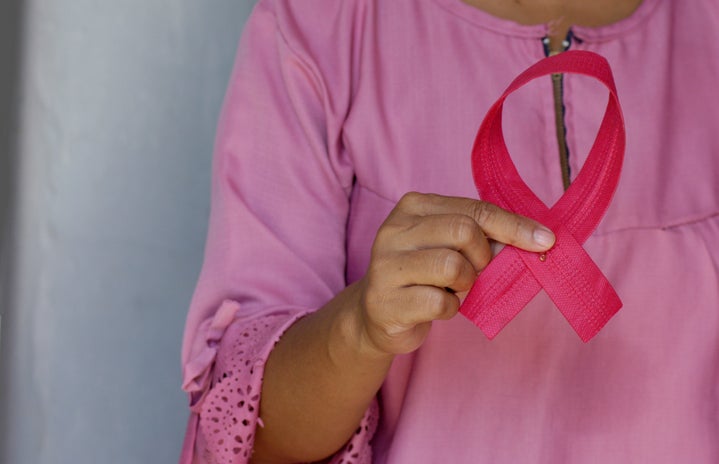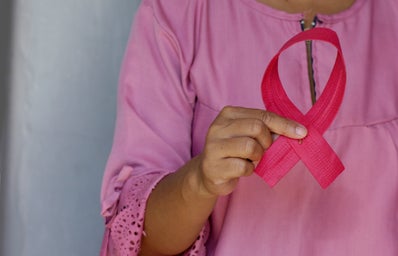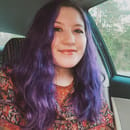I think one of the most important things to know about breast health is that just because the risk for breast cancer increases with age (https://www.cdc.gov/cancer/breast/basic_info/risk_factors.htm), doesn’t mean that people in their 20s and 30s shouldn’t perform breast self-exams. Aside from breast cancer, there are other things to look for. In fact, fibroadenomas (which are noncancerous lumps found in the breast) are most commonly found in women between the ages of 15 and 35; and there are more than 200,000 cases of fibroadenomas in the U.S. per year (https://www.mayoclinic.org/diseases-conditions/fibroadenoma/symptoms-causes/syc-20352752).
In this article, I’m going to share a personal experience I had through an essay I wrote my freshman year of college:
I was only 14 years old when I discovered the tumor. It felt like a hard knot in my breast and I wasn’t sure how long it was there before I found it. After doing a google search on what it could be, I ran to my mom’s room panicking because I thought I had breast cancer. She was slightly alarmed too, because it was abnormal for someone my age to have a lump in the breast. We skipped going to my primary physician and called the breast center to make an appointment.
I remember feeling extremely nervous when I got there. All of the patients were older women, and the room was filled with breast cancer pamphlets and posters. It had a depressing, yet hopeful feel to it. Some patients received the worst news they could imagine in that room; and some found out that they survived it. I didn’t know what to expect when it was my turn. I had so many thoughts going through my head.
My mom came back into the room with me, where I was given an exam and x-rays. They asked about my family history and if I felt any pain or discomfort, which I didn’t. My breast specialist was a young, yet reputable surgeon who had expertise in breast health. She told us that it was a normal, small, lump that sometimes develops in young women when there is too much breast tissue. I felt a lot of relief hearing the word “normal” come out of my doctor’s mouth. I was scheduled to come in every 6 months for a check-up.
I went to every one of my appointments, where I was just given a breast exam and told that everything was normal. At this point, I wasn’t bothered by the lump and I didn’t worry too much about it. My appointments were changed to once every year, unless I felt that I needed to go in sooner.
It wasn’t until right after my 17th birthday that I started feeling discomfort in the breast where the lump was located. My appointment was only weeks away, so I waited until then to bring it up to my doctor. When I got to my appointment, they did the same procedures as the years before. Only this time, they noticed that the lump had grown drastically in size. That is when they actually diagnosed the lump as a fibroadenoma, which is a benign (noncancerous) tumor that often occurs in young women.
I was told that I needed to either have a breast biopsy to confirm that it was a fibroadenoma, or skip a step and have the surgery to remove it. Both options sounded horrifying because I never had surgery before, and even if I did the biopsy, I would more than likely still have to have the surgery later on. After discussing the options with my mom and my doctor, we decided to go ahead with the surgery. My doctor said that I made the right decision because they recommend surgery based on three factors; the size of the lump, growth, and discomfort. It had grown over three centimeters within the year and the pain indicated that it was something I had to do now before it got worse.
After we came to the conclusion, my doctor went over the surgery and gave me the option to have the incision made around my areola, which would be more accessible to the lump, or underneath of my breast, called an inframammary incision, which would be more cosmetically appealing. She suggested that most young women decide to have it done underneath due to the appearance of the scar, and I agreed. She told me that I would be put under anesthesia and the only pain I would experience would be from recovery but that I would be able to return to school the following week; which was a relief because I was in my first semester of senior year and I couldn’t risk missing too much school. She went over everything I needed to know and my surgery was scheduled for one month later.
I was really stressed out over the procedure, which would take place on the Thursday before Thanksgiving break. It was important to discuss any known future absences with the teachers, so I told them that I would be having surgery and would be out for the last two days before break started. Each one of them asked what kind of surgery I was having, and I felt really embarrassed telling them for some reason. I even had a hard time telling my friends because I knew that it wasn’t a typical surgery and I would get a lot of questions. When I tried to explain the procedure, they all had the same reaction; gasping at the thought of a high school girl having to go through something so serious, and looking at me as if I had just been hit by a bus. I didn’t like people feeling bad for me; it made me feel weak, and even more scared than before.
Before I knew it, it was time to drive about half an hour to the hospital where I would have my surgery. I got there at about eight o’clock in the morning, and my surgery was scheduled for ten o’clock. I was put into the pre-op room where I had to take off everything, put on a hospital gown, and prepare for surgery. The nurse came in to give me the IV fluids, which was pretty painful because she had to poke me a couple of times before she found the vein; probably because I was dehydrated from not being allowed to eat or drink the night before. This was the last thing I remembered before I was put under anesthesia.
The surgery was in-patient and lasted for about an hour and a half. I woke up panicking in the recovery room; nurses surrounding me, noises from all of the equipment, and chaos everywhere. I was crying hysterically, not from the pain, but from the anxiety of waking up not knowing anything. The nurse mistook my crying as a sign that I was in pain, and I wasn’t able to answer her questions clearly, so she gave me way more pain medication through the IV than I needed. She gave me so much Percocet that I kept falling asleep on the hospital bed. Every time I fell asleep, my breathing would drop and nurses had to come in to give me oxygen.
My breast specialist (the same one who diagnosed the fibroadenoma) was also the one who performed my surgery. I felt comfortable with her, as she had been doing these procedures on women for over 15 years. She came into the room to talk to my mom, and explained to her that the procedure was a lot harder than she expected it to be. She had to go through the underneath of my breast and pass all of the tissue in order to find the tumor, which was located right above my areola. “Not to scare you, but I had to do a lot more work on you than I’ve had to do on breast cancer patients with several tumors,” she said with a light tone of voice. This made me feel strong for going through it, even though it wasn’t over yet.
It was around five o’clock when I got home. I was so tired and out of it from the medication, I instantly fell asleep and woke up a couple of hours later. The pain didn’t start until about ten o’clock that night. It was a sharp, agonizing pain all around the breast I had surgery on. It swelled up hard as a rock, and felt as if it was made of steel; which is not an exaggeration. It was completely bruised up, swollen, and stiff. I had to keep ice on it all day and wear compression sports bras for weeks after surgery to prevent it from swelling.
I stayed home all of Thanksgiving break taking my pain medications, resting, and trying to heal. A few days before break was over, I began breaking out in hives all over my body. I ended up having to stay home from school, for what I thought would only be a few days. After a few appointments with my breast doctor, we determined that it was an allergic reaction from either the pain medicine or the “medical glue” that kept my incision together. Since I wasn’t able to take any pain meds, I was in excruciating pain and still covered in red, itchy bumps.
At this point I wasn’t sure if I would be able to pass my classes. Finals were a week and a half away, and I had several missing assignments in each class. My parents even received an email from my school stating that I was about to be unenrolled from my classes and fail due to absences. This was extremely hard on me because I worked so hard to get good grades and I thought that everything had been ruined for me. Gradually, the allergic reaction went away but I was still so behind and felt hopeless. I didn’t believe that I could possibly make up for all the work I missed, let alone get straight A’s like I had planned for.
After contemplating my options for summer school or online school, I came to the conclusion that I wasn’t going to let everything go that easy. I needed to take control of the situation. I had what some may call an epiphany and I realized that I’ve been through too much to not graduate because of a surgery with inconvenient timing. I was determined and ready to prove to myself that I was capable of doing anything I set my mind to. I took a deep breath, drove to my school, had a mini panic attack in my car, and walked into the building like I owned it. I was about to do what I thought was impossible.
I’m now twenty-one years old and this experience was one that I won’t forget. I even have a (very nicely healed) scar to remember it by. While it was a nightmare to deal with at the time, I feel like it gave me the chance to show myself how strong I am, as well as how strong so many women are. I’m grateful that it wasn’t cancer, but it really opened my eyes to the obstacles that breast cancer patients face. I know what it’s like to sit in that waiting room, to wait nervously for an invasive surgery, to read through those breast cancer pamphlets and worry. I also know what it’s like to deal with the mental and physical challenges after having surgery. Given that October is Breast Cancer Awareness Month, I would just like to say that women who have/had breast cancer are some of the most powerful women you’ll ever meet. Also, check on your breasts! You can learn how to perform a breast self-exam through five simple steps: https://www.breastcancer.org/symptoms/testing/types/self_exam.
If you’d like to learn more about breast cancer awareness and why it is so important, I encourage you to read Camryn Lapp’s article “Breast Cancer Awareness: Taking One Step At A Time To Fight The Spread” on Coastal Carolina’s Her Campus website (https://www.hercampus.com/school/coastal-carolina/breast-cancer-awareness-taking-one-step-at-a-time-to-fight-the-spread/). You can also support the Breast Cancer Awareness Foundation by purchasing a Breast Cancer Awareness t-shirt from Her Campus at Coastal Carolina University (https://www.customink.com/fundraising/her-campus-at-ccu-breast-cancer-awareness-fundraiser?utm_campaign=desktop-post-launch-v3&utm_content=her-campus-at-ccu-breast-cancer-awareness-fundraiser&utm_medium=social&utm_source=copy-link&fbclid=IwAR3-JivD0orlFl7-Ka3j9IazxLoq4fcuFATevTBWnhNbYK94YkfX-HHMQCc).


